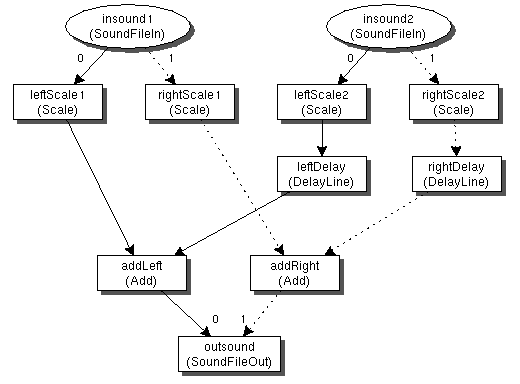Introduction to sig++
Sig++ is a set of C++ classes intended
for use in creating sound synthesis/filtering programs -- primarily
using the elegant and sophisticated
environment of a Unix shell.
Sig is somewhat similar to cmix, but
is designed for use in a real program by someone who has already
taken courses in C/C++ -- after the program is written and compiled
using sig it should be general-user friendly (see
example programs). Eventually I may
write an interpreter script to combine signal generators and control
them, or maybe not. Sig is also somewhat similar to Perry Cook's Synthesis
Toolkit (STK).
Another similar project is called
spkit from
the University of Helsinki Music Research Laboratory.
Computational efficiency is important,
but perhaps not as much as readable code and generality.
The end goal is to generate nice, simple yet powerful
computer-music composition tools that can be used on any type
of (Unix) computer as well as support functions in larger programs
such as this picture-to-sound converter.
See clm
if you can't wait around for something more encompassing.
The paradigm for the sig++ signal-processing implementation is to
imagine a flowgraph consisting of signal manipulators which are connected
to each other to do something interesting. Sig is not graphical,
unless someone else writes a graphical interface to do code generation,
such as in
SynthBuilder.
An example flowgraph could be the following:
 This flow graph is for mixing two soundfiles together with either
a Mono or Stereo format. Each channel of the input sounds can be
amplitude scaled independently, and insound2 can be delayed by
a certain offset from the beginning of insound1.
This flow graph is for mixing two soundfiles together with either
a Mono or Stereo format. Each channel of the input sounds can be
amplitude scaled independently, and insound2 can be delayed by
a certain offset from the beginning of insound1.
The implementation in code of the preceding picture is rendered
in the mix.cpp example program as:
leftScale1.connect(insound1);
leftScale2.connect(insound2);
leftDelay.connect(leftScale2);
addLeft.connect(leftScale1);
addLeft.connect(leftDelay);
outsound.connect(addLeft);
if (header.getChannels() == 2) {
rightDelay.setDelay(offsetSamples);
rightScale1.connect(insound1, 0, 1);
rightScale2.connect(insound2, 0, 1);
rightDelay.connect(rightScale2);
addRight.connect(rightDelay);
addRight.connect(rightScale1);
outsound.connect(addRight);
}
The round objects in the picture above are Signal Generators:
objects which accept no input signal, but generate output signals.
The rectangular objects in the picture above are Signal Filters:
objects which accept both input and output signals. Signal Filters
could be replace by Signal Generators by just not giving any
inputs to a Signal Filter, but for pedagogical purposes, I
split the Signal objects into those two general categories.
All Signal objects can have an arbitrary number of inputs
(except Signal Generators, of course) and also an arbitrary
number of inputs. In the picture above, the little numbers
near the connections refer to the input/output channel that an
object is receiving/sending a signal on. Inputs can be
connected to outputs of other signals, or they can be set to
fixed values. One major advantage of this setup is that
input parameters can be either fixed at a constant value, or
can be varied in time. See for example the
resonator.cpp example program
which uses the
Resonator class and
which can create neat time-varying filtering
effects on soundfiles/whitenoise
(resonator sound [ .wav]).
Signals traveling between signal filters are in floating
point (doubles), and must be normalized between +/- 1.0 for
saving to output soundfiles (for now).
Sig is designed to be generalized C++ code as much as possible so that it
will port easily to any computer with a C++ compiler with slight modifications
only for hardware IO (today, we are in the Dark Ages of sound IO). Currently,
sig is working and being tested in these operating systems (see
downloads):
- OpenStep 4.0 or higher on Intel computers.
- NextStep 3.2 or higher on Intel computers.
- NextStep 3.2 or higher on Motorola computers.
- Linux 2.0.29 with gcc version 2.7.2.1 on Intel computers.
- IRIX 5.3 on SGI computers.
- Sun SPARCstations
- HP-UX
- Windows 95 with visual C++ 5.0.1
The classes for sig++ are grouped into sublibraries which
organize classes with similar functions. Also, there are two
sublibraries called improv and museinfo which
are self-contained subsets of the sig library.
The classes for sig++ are described here.
Example programs which use the library classes above are organized
by one of the three complete libraries:

Craig Stuart Sapp, 
